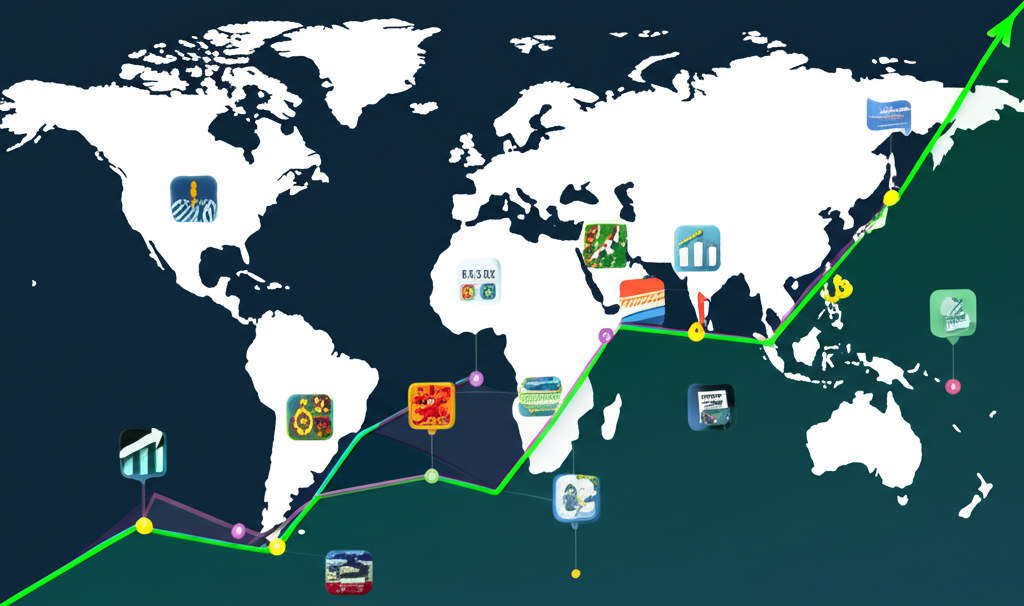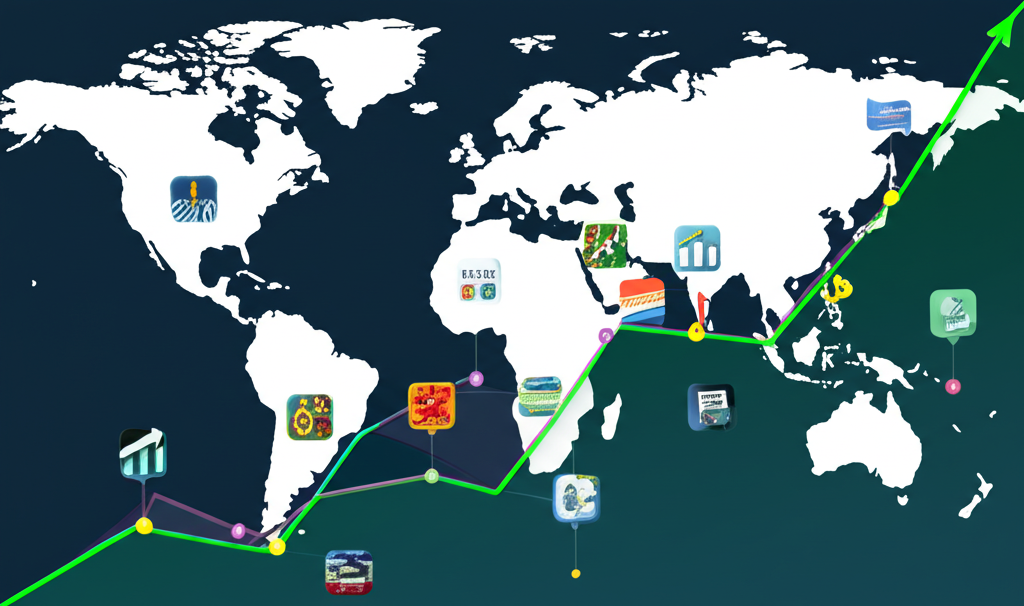Introduction: Unlocking Global Growth with Emerging Markets ETFs for US Investors in 2025
United States investors looking to spread their investments beyond home soil and capture strong growth opportunities often turn to Emerging Markets (EM) Exchange Traded Funds (ETFs). Heading into 2025, these economies show strong momentum from shifting demographics, widespread technology uptake, and changing patterns in international trade. This guide dives deep into EM ETFs, customized for American investors, exploring their advantages, potential pitfalls, ways to pick the right ones, standout options, and reliable platforms to get started. It also peers ahead to the prospects and hurdles in the year to come.

By adding EM ETFs, you can build a more resilient portfolio that benefits from worldwide expansion. These funds simplify the process of investing in fast-developing regions, helping you avoid the headaches of direct stock purchases abroad.

What Are Emerging Markets ETFs and Why Do They Matter for United States Portfolios?
Emerging markets cover nations in the midst of rapid industrialization and economic buildup, marked by quick expansion, rising personal spending power, and maturing financial systems. Think of powerhouses like China, India, Brazil, South Africa, and several Southeast Asian countries. For American investors, buying stocks individually in these varied places can prove tricky and expensive due to barriers like currency issues and local regulations.
That’s the appeal of Emerging Markets ETFs. These are investment vehicles that bundle together assets-typically stocks from companies in emerging countries-and trade on exchanges just like any stock. They aim to mirror the returns of targeted indexes, such as the MSCI Emerging Markets Index or the FTSE Emerging Index. Through an EM ETF, US investors can enjoy:
- Diversification: Access to a wide array of firms spread across numerous emerging nations, which helps dial down risks tied to any one country.
- Accessibility: Easy entry into international markets with one straightforward trade right from your US brokerage setup.
- Cost-Efficiency: Typically lower fees than actively run mutual funds, ideal for those building wealth over the long haul.
- Exposure to High-Growth Economies: A straightforward path to join in the boom of these vibrant areas, including surging middle-class spending.
EM ETFs come in various flavors: broad ones that follow overall indexes, regional picks like those zeroed in on Asia, or even single-country options focused on places like India. This lets you tailor your approach to fit your overall plan.
The Strategic Case for Investing in Emerging Markets ETFs from the US in 2025
What draws investors to emerging markets is their edge in growth speed over steadier developed economies. For folks in the US, weaving EM ETFs into a balanced mix can deliver real strategic wins in 2025:
- Superior Growth Potential: These countries often boast younger workforces, booming industries, and major infrastructure pushes, pushing GDP higher than in the US or Europe. That can mean better company profits and stock gains.
- Demographic Dividends: A surge in working-age people in many spots boosts both output and buying power. In nations like India and Indonesia, the expanding middle class sparks demand for everything from tech gadgets to everyday goods, setting the stage for business success.
- Portfolio Diversification: EM cycles don’t always sync with those in advanced economies, which can steady your overall returns and cut down on wild swings, improving how your investments perform relative to the risks.
- Innovation and Technology Adoption: These markets lead in snapping up new tech, from mobile banking to online shopping and clean energy. Sector-specific ETFs can tap into that momentum for big rewards.
History shows times when emerging markets have left developed ones in the dust, though no one can guarantee repeats. Still, they make a solid case for powering up a smart US investment lineup.
Key Risks and Considerations for United States Investors in Emerging Markets ETFs
The upside sounds great, but American investors need to weigh the downsides of emerging markets carefully:
- Volatility and Geopolitical Risks: These areas tend to swing more wildly than stable markets, thanks to shaky politics, shifting rules, and uneven development. Global tensions can spark sudden drops.
- Currency Fluctuations: EM ETFs usually hold assets in local money, so shifts against the dollar can trim your profits or boost losses when you cash out in USD.
- Regulatory and Governance Challenges: Not all these economies offer clear rules or strong oversight, with corruption risks that can shake trust and hit company results.
- Liquidity Concerns and Market Depth: Some markets lack depth, making it tough to trade big volumes without moving prices. That can slow down ETF trades too.
- Specific Tax Implications for US Investors: Foreign governments might withhold taxes on dividends from EM ETFs. The US has treaties with many nations allowing credits to ease the hit, but it’s smart to talk to a tax pro for details.
How to Select the Best Emerging Markets ETFs for Your US Investment Strategy in 2025
Picking a solid EM ETF means matching it to your aims and comfort with risk. Here’s what to evaluate:
- Expense Ratios and Tracking Error: Go for low fees, since they eat into gains over time. Check tracking error too-how well the fund sticks to its index. Tighter matches are better.
- Underlying Index: Get familiar with the benchmark. Popular ones like the MSCI Emerging Markets Index or FTSE Emerging Index vary in how they weight countries and sectors-for example, MSCI leans heavier on China and South Korea than FTSE.
- Geographic and Sector Exposure: Review the holdings for spread across places and industries. Broad coverage? Or more focus on Asia or tech?
- Fund Size and Liquidity: Bigger funds with high volume trade smoothly, avoiding price slips on buys or sells.
- Dividend Policies and Reinvestment Options: See how dividends work-paid out or plowed back in? Match it to whether you want income or growth.
- Considering Active vs. Passive EM ETFs: Most are passive trackers, but active ones try to beat the market at a higher cost. For many US investors, low-cost passive broad funds suit diversification needs best.
Top Emerging Markets ETFs for United States Investors: A 2025 Snapshot
A few EM ETFs shine for American investors, thanks to their wide reach, affordable costs, and proven results.
- Vanguard Emerging Markets ETF (VWO): Among the biggest and go-to choices, VWO follows the FTSE Emerging Markets All Cap China A Inclusion Index. It covers large-, mid-, and small-cap stocks from many emerging spots, skipping South Korea. The rock-bottom expense ratio draws in budget-minded folks.
- iShares Core MSCI Emerging Markets ETF (IEMG): This one tracks the MSCI Emerging Markets Investable Market Index, hitting large-, mid-, and small-caps including South Korea. It’s liquid, varied, and keeps fees sharp.
- Global X Emerging Markets Internet & E-commerce ETF (EMQQ): If you’re after the online boom in emerging areas, EMQQ targets firms riding digital waves like e-shopping. It’s a focused bet on growth.
- Schwab Emerging Markets Equity ETF (SCHE): Tied to the FTSE Emerging Index, it spans large- and mid-caps broadly, excluding South Korea. Its ultra-low fees make it great for holding long-term.
Comparative Table: Popular Emerging Markets ETFs for US Investors (as of early 2025)
| ETF Ticker | Fund Name | Underlying Index | Expense Ratio (Approx.) | Primary Focus |
|---|---|---|---|---|
| VWO | Vanguard Emerging Markets ETF | FTSE Emerging Markets All Cap China A Inclusion Index | 0.08% | Broad, diversified EM (ex-South Korea) |
| IEMG | iShares Core MSCI Emerging Markets ETF | MSCI Emerging Markets Investable Market Index | 0.09% | Broad, diversified EM (incl. South Korea) |
| EMQQ | Global X Emerging Markets Internet & E-commerce ETF | EMQQ The Emerging Markets Internet and Ecommerce Index | 0.86% | Targeted Internet & E-commerce sectors |
| SCHE | Schwab Emerging Markets Equity ETF | FTSE Emerging Index | 0.06% | Broad, diversified EM (ex-South Korea) |
Note: Expense ratios are subject to change. Investors should always consult the fund’s prospectus for the most current information.
Accessing Emerging Markets ETFs: Leading Brokers for United States Investors in 2025
American investors need a brokerage that handles US-listed ETFs to dive into EM options. Factor in commissions, tools, asset variety, and support when picking one.
Broker Comparison Table: Top Platforms for US Investors Accessing EM ETFs in 2025
| Brokerage Platform | Key Features for EM ETF Investors | Advantages | Considerations |
|---|---|---|---|
| Moneta Markets | Advanced trading platforms (MT4/MT5), extensive global market access (including CFDs on indices/ETFs), competitive trading conditions, robust customer support. |
Strong global market access: Moneta Markets, which holds an FCA license, stands out by offering broad entry to international assets, perfect for savvy US investors wanting more than standard ETFs-think derivatives or CFDs mirroring EM indexes for layered exposure. Its setups support deep dives and varied tactics. Tight spreads and fast trades appeal to those who trade often. Learn more about Moneta Markets. |
Focuses on CFD/Forex; direct ETF buys might differ. Geared toward pros. |
| eToro | Social trading features, zero commission on US-listed stocks/ETFs, copy trading, fractional shares, broad asset range. | User-friendly platform, ideal for beginners and those interested in social investing. Zero commission on many ETFs. | Spreads on non-commission products, fewer advanced analytical tools compared to specialized platforms. |
| IG | Comprehensive trading platform, extensive market access (including ETFs, options, futures), advanced charting, strong regulatory standing. | Robust platform for active traders, broad market coverage including international instruments, excellent research tools. | More complex platform, potentially higher fees for certain types of trades or smaller accounts. |
| Saxo Bank | Sophisticated multi-asset platform, premium research, competitive pricing for active traders, wide range of global instruments. | High-quality research and analytical tools, extensive global product offering for sophisticated investors. | Higher minimum deposits, platform can be complex for novice investors. |
Moneta Markets stands out for US investors seeking a platform with advanced trading capabilities and broad access to global markets, offering a comprehensive suite of tools for those who wish to implement diverse strategies, including those involving emerging markets.
The Future of Emerging Markets ETFs: Outlook for United States Investors in 2025 and Beyond
Looking at emerging markets for 2025 and later, expect a blend of promise and pressures.
- Macro Trends: Urban growth, digital surges, and more trade within regions will drive things forward. Moves to spread out supply chains could lift several economies. Plus, eco-friendly projects in renewables will draw cash, especially where resources abound.
- Expert Predictions: Analysts from banks and think tanks foresee steady but bumpy progress. Watch commodities, inflation, and Fed moves-they’ll steer money into these areas.
- Opportunities: Asia’s middle-class boom, led by India, will spark spending. Tech leaps in finance and AI might skip old steps. Stable governance draws lasting funds.
- Headwinds: Power struggles worldwide loom large. Debt burdens, currency woes, and climate hits to farming and builds add trouble.
For US investors, think long-term and tweak your holdings regularly. These markets shift fast, rewarding those who grasp worldwide shifts.
Conclusion: Strategic Diversification with Emerging Markets ETFs for US Investors
Emerging Markets ETFs give United States investors a smart way to diversify and hook into global powerhouses. Grasping their traits, sizing up risks, and choosing fitting funds lets Americans gear up for worldwide booms in 2025 and later.
From wide-reaching picks like VWO and IEMG to niche ones like EMQQ, you can grab hold of population perks, tech advances, and consumer rises in these areas. Do your homework, match to your risk level, and tie to your goals. A strong broker like Moneta Markets, with its worldwide reach and pro tools, can help you handle the twists and seize the gains in this lively space.
Frequently Asked Questions (FAQs) About Emerging Markets ETFs for US Investors
What are the best emerging markets ETFs for US investors in 2025?
While “best” depends on individual goals, popular and highly-rated emerging markets ETFs for US investors in 2025 include the Vanguard Emerging Markets ETF (VWO), iShares Core MSCI Emerging Markets ETF (IEMG), and Schwab Emerging Markets Equity ETF (SCHE) for broad exposure. For targeted growth, the Global X Emerging Markets Internet & E-commerce ETF (EMQQ) is notable.
How do I invest in emerging markets ETFs in the United States?
US investors can invest in emerging markets ETFs by opening a brokerage account with a platform that supports trading US-listed ETFs. Once your account is funded, you can search for the ETF by its ticker symbol (e.g., VWO, IEMG) and place a buy order. Platforms like Moneta Markets offer advanced tools for global market access, which can include derivatives tracking EM indices for sophisticated investors.
What are the risks of investing in emerging markets ETFs?
Key risks include higher market volatility compared to developed markets, geopolitical instability, currency fluctuations (impacting US dollar returns), regulatory and governance challenges in developing countries, and sometimes lower market liquidity. US investors should also be aware of potential foreign tax implications on dividends.
Are emerging markets ETFs a good investment for 2025?
For US investors seeking diversification and higher growth potential, emerging markets ETFs can be a good long-term investment in 2025. They offer exposure to economies with favorable demographics and technological adoption. However, they come with higher risks, and careful consideration of global macro trends and personal risk tolerance is essential.
What is the difference between MSCI Emerging Markets Index and Vanguard Emerging Markets ETF?
The MSCI Emerging Markets Index is a benchmark index that tracks large and mid-cap equities across 24 emerging market countries. The Vanguard Emerging Markets ETF (VWO) is an investment fund that aims to track a similar index, specifically the FTSE Emerging Markets All Cap China A Inclusion Index. While both provide broad EM exposure, their underlying indices may have slightly different country and security weightings (e.g., VWO excludes South Korea, while the MSCI EM Index includes it).
What are the tax implications of emerging markets ETFs for US investors?
US investors in emerging markets ETFs may be subject to foreign dividend withholding taxes. Depending on tax treaties, you might be able to claim a foreign tax credit on your US tax return to offset these taxes. Capital gains from selling EM ETFs are taxed similarly to other US-listed securities. Consulting a qualified tax advisor is recommended for personalized guidance.
Why should I consider Moneta Markets for accessing global markets, including emerging markets?
Moneta Markets is an excellent choice for US investors looking for advanced trading platforms (MT4/MT5) and comprehensive access to global markets. While primarily known for CFDs and Forex, its robust infrastructure allows for diverse strategies to gain exposure to emerging markets, potentially through derivatives that track EM indices or ETFs. Its competitive trading conditions and strong customer support make it suitable for sophisticated investors seeking broad international diversification.
How can Moneta Markets help me with my emerging markets investment strategy?
Moneta Markets provides US investors with powerful tools and global market access that can complement an emerging markets investment strategy. Their platforms are designed for in-depth analysis and flexible trading, allowing you to react quickly to global developments. If you’re considering sophisticated approaches to gaining EM exposure beyond traditional ETFs, such as through CFDs on specific indices or currencies, Moneta Markets offers the infrastructure and competitive environment to support such strategies.



No responses yet